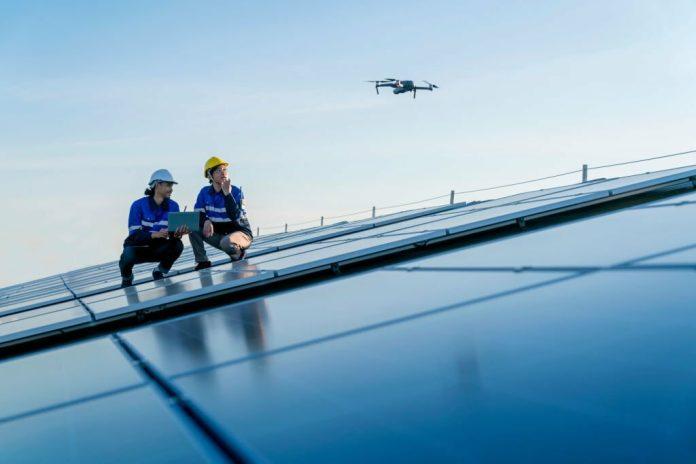For home buyers, one of the most important parts of a home inspection is an examination of the roof. The roof is a home’s first line of defense against the elements, and a compromised roof can lead to catastrophic damage from water leaks, mold growth, and rot. Traditionally, roof inspections have been limited in their ability to thoroughly evaluate every inch of a roof. Inspectors typically rely on binoculars and ladder work to visually assess the roof surface and components. But new drone technology is revolutionizing the way roof inspections are performed, providing far more detail and enabling inspectors to identify problems they simply couldn’t see before.
How Drones Improve Roof Inspections
Drones provide huge advantages over traditional manual roof inspection methods. Equipped with high-resolution imaging capabilities, drones can capture crystal-clear aerial photos and video of every seam, angle, layer, and component of the roof. Highly maneuverable and stable even in windy conditions, drones can hover, rotate, and access hard-to-reach spots like roof peaks, valleys, vents, and chimneys.
Unlike inspectors on the ground, drones provide a bird’s eye view that allows the identification of widespread problems or damage across large sections of the roof. Thermal imaging cameras can detect areas of moisture intrusion, inadequate insulation, or energy loss that may point to leaks, poor ventilation, or other issues. The permanent visual record captured by drones aids in documentation, insurance claims, and contractor repairs.
For home buyers specifically, drone roof inspection provides far greater transparency into the condition of the roof before purchase. In a competitive market, buyers want assurance that the roof will not require major repairs or full replacement soon after move-in. Sellers also benefit from being able to thoroughly demonstrate the sound condition of the roof before listing.
Drone Inspections Identify Common Roofing Issues
Advanced drone roof inspection can identify many common roofing problems that could impact structure, durability, and energy efficiency:
- Damaged, missing, cracked, or curled shingles or tiles
- Faulty or deteriorated flashings around chimneys, vents, and valleys
- Exposed nail heads that can lead to water seepage and leaks
- Clogged gutters and downspouts that can cause water pooling on roofs
- Moss buildup which retains moisture and rots wood decking
- Sagging or deformation of roof sections indicating structural issues
- Rusting drip edges, ridge vents, and other components
- Deteriorated caulking around skylights, joints, and seals
- Insufficient attic ventilation leading to premature roof wear
In addition to physical roof components, drones equipped with thermal imaging can detect temperature variances that point to insulation gaps, air leaks, moisture retention, and other energy efficiency issues. Drones expand an inspector’s visibility to provide a level of detail and thoroughness not possible from the ground.
Drone Inspections for All Roof Types
Drone roof inspection technology works equally well on all common roof types:
Asphalt Shingle Roofs:
The most popular roofing material. Drones easily spot curled, broken, or missing shingles across large expanses.
Metal Roofs:
Drones see punctures, rusting, exposed nails, and seam separation on metal roofs. Thermals detect insulation issues.
Tile Roofs:
Cracked, broken, or slipped tiles are evident in drone photos. Flashings, eaves, and grout lines are inspected.
Flat Roofs:
Ponding water, blisters, cracking, and punctures are identified by drones. Great for hard-to-access commercial flat roofs.
Wood Shake/Shingle Roofs:
Curled, warped, and brittle shakes are visible from the air along with moss and mold growth.
Drone inspection works for any pitched or flat roof, residential or commercial. Superior high-altitude perspective compared to in-person visual inspection from a ladder or lift.
Choosing the Right Drone and Camera Package
To reap the benefits of drone roof inspection, it’s important to select the right drone model and imaging capabilities:
- Stable, weather-resistant platform optimized for roof inspection
- High-resolution visual camera to capture photos and video
- Thermal imaging camera to detect moisture issues
- Ability to pre-program automated flight pattern for full coverage
- Safety features like obstacle avoidance sensors
- 25+ minutes of flight time to cover the average home
- FAA Part 107 certified remote pilot operating the drone
Communicating Drone Inspection Results
Skilled interpreters review drone roof inspection footage to identify areas in need of repair, replacement, or further evaluation. The best providers deliver a documented report explaining roof conditions with accompanying visual evidence. For home buyers, this includes a rating on current condition, remaining useful life, and major findings.
Drone inspection reports may recommend:
- Specific repairs like re-sealing sections or replacing damaged shingles
- Preventative treatments to limit moss growth or inoculate for pests
- Further evaluation of underlying structural issues
- Full roof replacement due to age, extensive damage, or end-of-lifespan
- Improvements to attic ventilation, insulation, and energy efficiency
Drone inspection gives home buyers and sellers a level of clarity into roof conditions that protects their interests and makes smart decisions possible.
The Future of Drone Roof Inspection
As drone technology improves, so will the capabilities for roof inspection. Lighter platforms, longer flight times, smarter navigation, and higher-resolution cameras will enable even more detailed roof assessments. Integration of other sensor data beyond visual and thermal will provide inspectors with incredibly rich perspectives. And as drones become more cost-effective and mainstream, they will become a standard part of every home buyer’s due diligence process.
Drone roof inspection is revolutionizing the industry by making the invisible visible. Eliminating uncertainty, drones give buyers, sellers, inspectors, and contractors the clearest possible view of a roof’s condition so they can act accordingly. For all parties, drones are an invaluable tool that provides clarity, transparency, and confidence.
